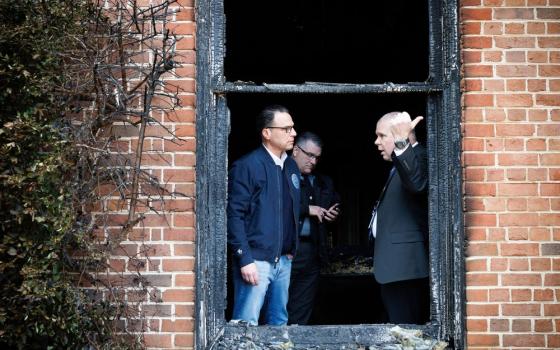
The baptism of the Lord is depicted in stained glass at the Cathedral of Immaculate Heart of Mary and St. Teresa of Calcutta in Baruipur, West Bengal, India. (Dreamstime/Zatletic)
This summer, I came across a digital image of the historical Jesus from Dutch artist Bas Uterwijk. This artist uses digital manipulation to display famous figures according to how they would have looked in their respective historical context.
I was shocked to see an image of Jesus who looked like me.
Growing up as an Indian American from an Eastern Catholic rite attending Roman Catholic Masses in English, I mainly encountered white images of Jesus and Mary. Additionally, I generally only saw white people in the congregation. I did not see a Christ or a congregation that resembled me.
Until Uterwijk's depiction of Jesus as a Middle Eastern man — the real Jesus looked like me.
I have lived my life in a Catholic Church where I have felt and often feel alone. My family was often the only Indian family in the parish, or one of few in the congregation. At one of the parishes my family attended growing up, there was a Goan Indian man who was the lector. A young parishioner approached me after Mass to commend my father for his excellence as a lector. But that was not my dad.
I entered two religious orders and I did not find community members based in the United States who looked like me. This lonesome experience meant I had trouble finding, growing into and expressing my identity as an Indian American. I generally felt I had to be someone else, and not the person who I am.
But when I look upon this image of Jesus that reverences the historical geography that our Lord became flesh in, I do not feel like an outsider. I feel at home.
How robbed I have been to overwhelmingly see images of Jesus as a white man, a Jesus who could not understand my experience as a person of color living in a country that wants to limit people looking like me from entering this nation.
But the real Jesus knows this experience. By the message of an angel, the Holy Family fled to Egypt to escape Herod's slaughtering of male Jewish infants.
The real Jesus was not accepted.
The real Jesus was Brown like me.
The real Jesus knew and knows my pain.
The real Jesus is with me.
This year, many have called for the tearing down of any and all white images of Jesus. For many Catholics of color, worship spaces that exclusively use white images to portray our faith contribute to the white supremacist undercurrents in the American church.
Images of white Jesus promote a false idol, one that leads us further and further away from the Gospel. The white Jesus results in believers who are apathetic or antipathetic to Black people and persons of color.
Advertisement
Therefore, we as a church, especially in the United States, need to welcome the real Jesus into our minds, hearts and churches. We must integrate the images, liturgical practices and homilies exhibited within faith communities of color. This inclusion would honor the real Jesus in his historical form by welcoming those like him.
This can happen in a variety of ways. First, I wish my parish priests invited us Indian Catholics to offer a brief reflection at Mass following Communion about our history in the faith and our experiences of the Sunday Gospel from our cultural context.
Second, I encourage white parishes to invite Indian Catholics to positions of leadership and ministry. By creating such spaces, pastors can invite Indian Catholics, and Catholics of color more broadly, to share what aspects of their worship traditions they would most like to see in their congregation.
My father's parish in India, St. Stephen, hosts a festival in honor of its patron saint every year on Dec. 26, his feast day. This event features a procession with a unique drum cadence and choreography, performances including Indian classical dance and religious music, and the sale of food and religious articles. Incorporating multicultural expressions of the faith not only honors the Christ worshipped in minority communities along with the people of this culture, but enriches the experience of Christ for the parish community beyond local and nationalistic images of Jesus.
Despite feeling alienated in whitewashed Catholic parishes, I do not want to see these images desecrated. While the white Jesus does not represent the historical Jesus and often perpetuates sentiments of white supremacy, if we truly believe that Christ can be seen in any person, then Christ can surely be seen as a white person, albeit not exclusively in white people. Rather, our parishes and our hearts ought to remove the notion of Christ seen only as white.
As Pope Francis stated in Evangelii Gaudium, "We would not do justice to the logic of the incarnation if we thought of Christianity as monocultural and monotonous." Parishes can introduce images and art that depict Christ and Mary as nonwhite people, as well as offer workshops on the faith traditions of Catholics in nonwhite cultures. These practices would reinforce the global nature of the Catholic Church, a paramount tenet of our catechism that has been lacking in praxis.
Including practices from communities like mine can also challenge white Catholics, especially those from a privileged socioeconomic class, to understand that dismantling privilege and supremacy are paramount to our Catholic faith.
The presence of the real Jesus in our parishes and our homes is long overdue.







